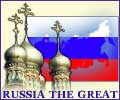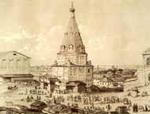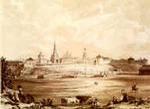| OVERVIEW |
 |
|
|
|
|
|
| Mail service |
 |
|
|
|
| Counters |
 |
|
|
|
| The best site 2004 |
 |
|

|
   |
|
|
History of the City
Pages: 1 2 3

Kazan - behind this word there is rich centuries-old culture of one of the most beautiful cities of Russia, reflected in the historical monuments, culture and architecture. Through the prism of history these monuments have brought to us many interesting things from the life of ancient Kazaners. Kazan has gone through many changes. From frontier city it has turned into the capital of the republic, into the cultural centre of the Tatar people, has given us many talented art workers, scientists, politicians.
Settling of territory of modern Tatarstan began in paleolith (about 100 thousand years ago).
The first state - Volga-Kama Bulgaria - appeared in the end of IX - beginning of X century AD and long time  remained the unique developed state formation in the northeast of Europe. In 922 islam was accepted the state religion. remained the unique developed state formation in the northeast of Europe. In 922 islam was accepted the state religion.
In XIII century the Bulgaria state was a part of empire of Chingiz-khan, and then became a part of Golden Horde. As a result of disintegration of Golden Horde in the 30s-40s of XIV century in the territory of the Volga region there was a new feudal state - Kazan Khanate. After Ivan the Terrible's capture of Kazan in 1552, Kazan Khanate stopped its existence and was attached to the Russian state.
In the beginning of 15 century Kazan was called New Bulgar - Bulgar-al-Dzhadid, - thus, giving it a status of capital city.

From the middle of 15 up to the middle of 16 centuries Kazan - capital of Kazan Khanate, rich and beautiful city, amazing contemporaries by strength of walls and magnificence of palaces and mosques. "Marvellous city", "capital of the East" - so was named Kazan. Even Ivan the Terrible admired the city. Skilful masters lived in Kazan: builders that erected magnificent city, tanners - that became famous in many countries for Bulgar or Kazan footwear, jewellers that created well-known "Kazan cap" - gold imperial crown which Ivan Terrible took along to Moscow after capturing Kazan.
In the second half of 16-17 centuries Kazan was capital of the east of Russia, the centre of extensive territory. The Kremlin was built in stone. Well-known Pskov masters - Yakovlev by nickname Barma (founder of Vasily the Blessed on the Red Square in Moscow) and Ivan Shiryay started construction. They constructed the Blagoveshensk cathedral in the Kremlin and began some other buildings.
All the life of Kazan in 16 and 17 centuries was the life of a military camp. On the Kremlin walls patrols went in the afternoon and at night, the fortress was surrounded by a filled with water ditch, bridges over it were risen for night, heavy stone gates of towers were locked.
In 17 century Kazan more than once had valiant times, was in the centre of peasants' revolts, revolts of non-russian population, in 1654-1657 there was plague, in 1672 and 1684 the whole quarters and streets were burnt down. However by the end of that hard century Kazan not only restored all destroyed, but became even better, turned to a large military administrative centre of Russia, and since 1708 headed the Kazan province. next>> Pages: 1 2 3
|
|
|
|
|
|
Traveller's view  |
|
|
| Sat Jul 5 |
| night / day: | °/°C |
 |
|
| Sun Jul 6 |
| night / day: | °/°C |
 |
|
|
|
|
|
Central Bank rates
|
|
 Dollar USA
Dollar USA
|

|
 Euro
Euro
|

|
|
| Navigation |
 |
|
|
|
| Search |
 |
|
|
|
|


